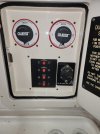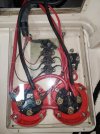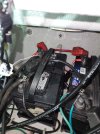...the circuit for my main panel that is.
When looking at my battery switch set-up, I was perplexed as to what wire actually fed the main panel. The wires to the batteries and engines are very heavy gauge and understandably so. The wire going to my main panel is only 8 ga on a 50 amp breaker. I thought to myself, that can't be it?! When I add up lights, wipers, pumps, and other electronics, this seems WAY to small for the potential demand, especially if fishing at night. Why would GW not provide more juice? Am I missing something?
When looking at my battery switch set-up, I was perplexed as to what wire actually fed the main panel. The wires to the batteries and engines are very heavy gauge and understandably so. The wire going to my main panel is only 8 ga on a 50 amp breaker. I thought to myself, that can't be it?! When I add up lights, wipers, pumps, and other electronics, this seems WAY to small for the potential demand, especially if fishing at night. Why would GW not provide more juice? Am I missing something?





